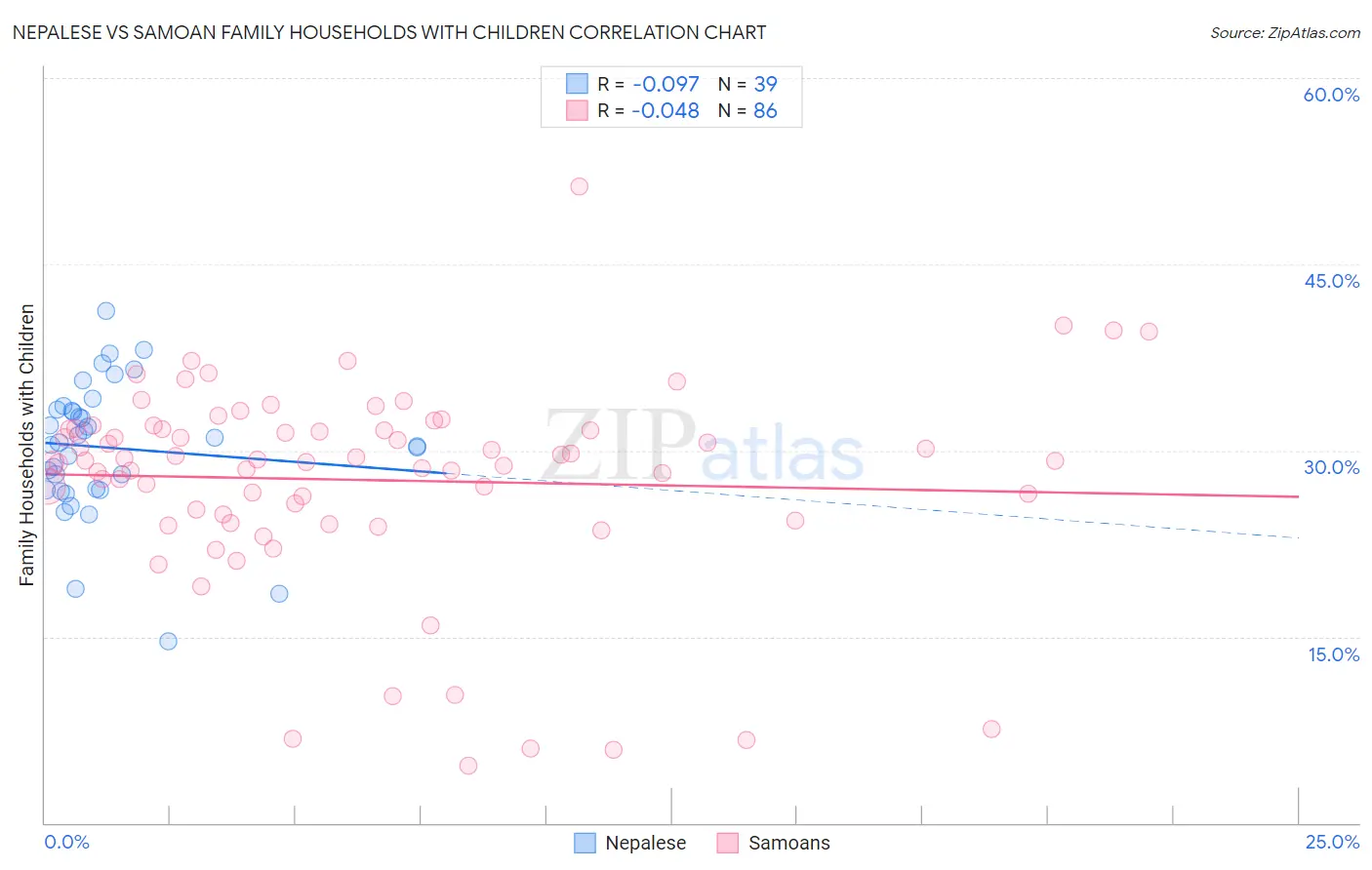Nepalese vs Samoan Family Households with Children
COMPARE
Nepalese
Samoan
Family Households with Children
Family Households with Children Comparison
Nepalese
Samoans
30.5%
FAMILY HOUSEHOLDS WITH CHILDREN
100.0/ 100
METRIC RATING
11th/ 347
METRIC RANK
29.5%
FAMILY HOUSEHOLDS WITH CHILDREN
100.0/ 100
METRIC RATING
28th/ 347
METRIC RANK
Nepalese vs Samoan Family Households with Children Correlation Chart
The statistical analysis conducted on geographies consisting of 24,519,269 people shows a slight negative correlation between the proportion of Nepalese and percentage of family households with children in the United States with a correlation coefficient (R) of -0.097 and weighted average of 30.5%. Similarly, the statistical analysis conducted on geographies consisting of 225,025,987 people shows no correlation between the proportion of Samoans and percentage of family households with children in the United States with a correlation coefficient (R) of -0.048 and weighted average of 29.5%, a difference of 3.5%.

Family Households with Children Correlation Summary
| Measurement | Nepalese | Samoan |
| Minimum | 14.7% | 4.6% |
| Maximum | 41.2% | 51.3% |
| Range | 26.5% | 46.7% |
| Mean | 30.2% | 27.6% |
| Median | 30.6% | 29.2% |
| Interquartile 25% (IQ1) | 26.8% | 24.8% |
| Interquartile 75% (IQ3) | 33.3% | 31.8% |
| Interquartile Range (IQR) | 6.5% | 6.9% |
| Standard Deviation (Sample) | 5.5% | 8.3% |
| Standard Deviation (Population) | 5.4% | 8.2% |
Demographics Similar to Nepalese and Samoans by Family Households with Children
In terms of family households with children, the demographic groups most similar to Nepalese are Immigrants from Fiji (30.5%, a difference of 0.080%), Thai (30.6%, a difference of 0.40%), Immigrants from Pakistan (30.2%, a difference of 0.88%), Afghan (30.2%, a difference of 1.1%), and Bangladeshi (30.1%, a difference of 1.4%). Similarly, the demographic groups most similar to Samoans are Bolivian (29.5%, a difference of 0.0%), Immigrants from Vietnam (29.5%, a difference of 0.16%), Sri Lankan (29.5%, a difference of 0.18%), Immigrants from Latin America (29.7%, a difference of 0.63%), and Guamanian/Chamorro (29.7%, a difference of 0.73%).
| Demographics | Rating | Rank | Family Households with Children |
| Thais | 100.0 /100 | #9 | Exceptional 30.6% |
| Immigrants | Fiji | 100.0 /100 | #10 | Exceptional 30.5% |
| Nepalese | 100.0 /100 | #11 | Exceptional 30.5% |
| Immigrants | Pakistan | 100.0 /100 | #12 | Exceptional 30.2% |
| Afghans | 100.0 /100 | #13 | Exceptional 30.2% |
| Bangladeshis | 100.0 /100 | #14 | Exceptional 30.1% |
| Immigrants | South Central Asia | 100.0 /100 | #15 | Exceptional 30.0% |
| Immigrants | Afghanistan | 100.0 /100 | #16 | Exceptional 30.0% |
| Hispanics or Latinos | 100.0 /100 | #17 | Exceptional 29.9% |
| Salvadorans | 100.0 /100 | #18 | Exceptional 29.9% |
| Alaska Natives | 100.0 /100 | #19 | Exceptional 29.9% |
| Immigrants | El Salvador | 100.0 /100 | #20 | Exceptional 29.8% |
| Immigrants | Laos | 100.0 /100 | #21 | Exceptional 29.8% |
| Malaysians | 100.0 /100 | #22 | Exceptional 29.8% |
| Mexican American Indians | 100.0 /100 | #23 | Exceptional 29.7% |
| Guamanians/Chamorros | 100.0 /100 | #24 | Exceptional 29.7% |
| Immigrants | Latin America | 100.0 /100 | #25 | Exceptional 29.7% |
| Sri Lankans | 100.0 /100 | #26 | Exceptional 29.5% |
| Immigrants | Vietnam | 100.0 /100 | #27 | Exceptional 29.5% |
| Samoans | 100.0 /100 | #28 | Exceptional 29.5% |
| Bolivians | 100.0 /100 | #29 | Exceptional 29.5% |